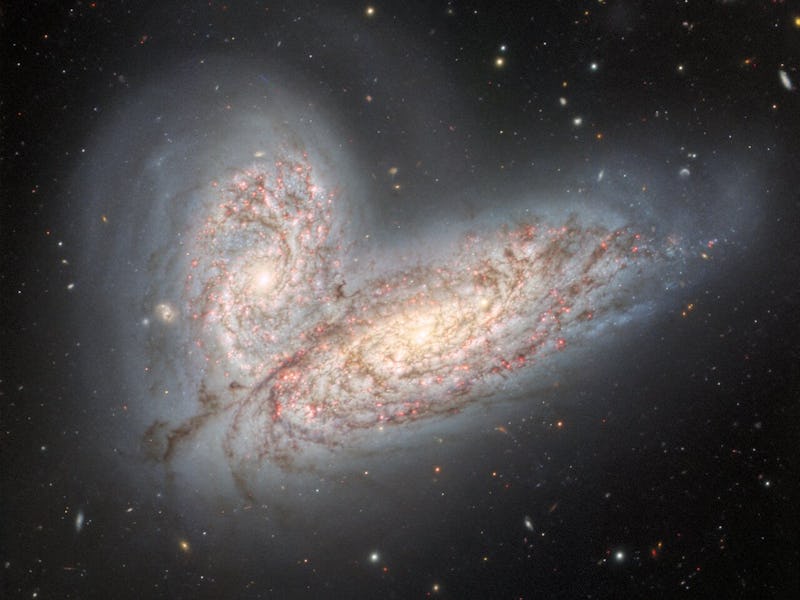Beware! Dramatic image of spiral galaxies previews the future fate of the Milky Way
This could be us, but you’re taking the picture 5 billion years too early.

These two merging galaxies are locked in a cosmic death spiral similar to the one that will ensnare our own corner of the cosmos in a few billion years.
In about 5 billion years, our small corner of the cosmos will look very different. Our Sun will swell into a red giant star, swallowing up the inner solar system. Around the same time, in a totally unrelated process, the Milky Way will finalize its merger with the nearby (and getting nearer every day) Andromeda Galaxy. The violence of the merger will destroy both galaxies’ intricate spiral structures, and the result will look something like the elliptical galaxy Messier 89 – a relatively featureless ball of aging low-mass stars and even older globular clusters.
This dramatic image from the Gemini North Telescope captures the early stages of another galactic death spiral, 60 million light years away, involving the spiral galaxies NGC 4568 and NGC 4567. The two galaxies are caught in each other’s gravitational pull. As they circle a shared center of gravity, each pass draws them closer together. At the moment, their galactic centers are about 20,000 light years apart — roughly the distance from Earth to the center of the Milky Way.
This image of spiral galaxies NGC 4568 (botton) and NGC 4567 (top) was created with data from the Gemini North telescope in Hawai’i.
Each time the two galaxies pass each other, each galaxy’s gravity draws long streamers of stars, gas, and dust from the other. It’s like a cosmic version of pulling taffy, and over the next 500 million years, that process will distort and smooth out the galaxies’ iconic spiral structure, leaving behind a simple spherical galaxy similar to Messier 89. Astrophysicists base this prediction on observations of mergers like this one and elliptical galaxies like Messier 89, and on computer models of the physics involved.
And like Messier 89, the giant galaxy after the merger will look much older and less active than the two spiral galaxies that formed it. When galaxies merge, stars don’t usually slam into each other; there’s enough open space between stars that the odds of that kind of crash are vanishingly small. The clouds of gas and dust between stars, however, will collide, and the shock waves from those collisions will create areas where the gas is suddenly denser and hotter; those areas will explode in waves of star formation.
By the time the merger is complete, most of the gas and dust in both galaxies will be part of stars formed during the collisions or it will have been blown away by the powerful stellar winds of newborn stars. Most of the stars left will be older and lower mass, since most of the really massive stars will already have lived out their short, energetic lives and met violent ends.
The result sounds a little depressing, honestly: cold, dim, and featureless compared to the active, intricately-structured spiral galaxies that came before.
Meanwhile, life — and death — goes on for stars in the doomed galaxies. If you look closely, you can spot the bright glow of a fading supernova remnant in a spiral arm of NGC 4568 (the lower galaxy in the image). The supernova, SN 2020fqv, was detected in 2020, the same year Gemini North collected the optical and infrared data that eventually produced this stunning image.
This article was originally published on